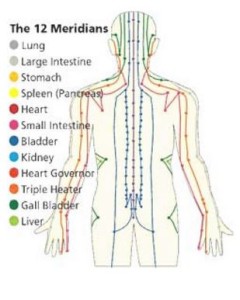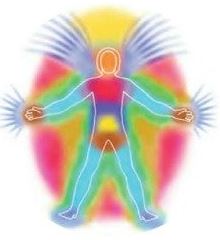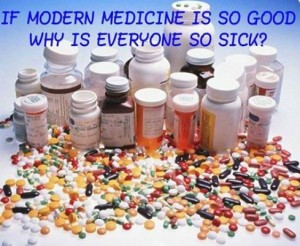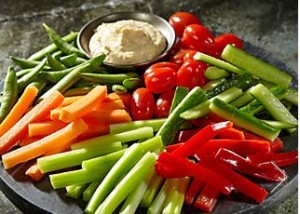Bioenergetic healing is nothing new. Many ancient cultures recognised an energy field within and around the body. Nowadays the latest scientific insights – especially those gained from quantum physics – are being applied to a better understanding of the body’s energy field and the information fields that direct it.
Traditional Chinese Medicine (TCM)
TCM has played an important part in the history and development of bioenergetic healing. It dates back at least four thousand years, and is a radically different way of understanding human health, physical function and the causes of disease than its Western counterpart. For instance:
- Whereas Western medicine sees the body as a stand-alone entity, in TCM, it has an intimate relationship with its environment.
- TCM is focussed on the person as a whole, rather than the disease alone.
- Western medicine tends to see the body as a collection of inter-dependent and inter-related parts; to the Chinese, it is a complete system with a set of interconnected sub-systems.
- At the heart of the TCM healing model is the flow of energy, ‘qi’ or ‘chi’, through the meridians. Disease is viewed as a lack of harmony or disruptions in qi. Practitioners try to influence the delivery and control of this subtle energy.
- Western physicians focus on the form and structure of the body and measurable organic changes; their Chinese counterparts are more concerned with function. They apply treatment to improve the functioning of the whole body, not just the faulty parts. Thus when Western practitioners speak of ‘blood’, they are referring to the red liquid that flows through the veins and arteries of the body; the Chinese concept of ‘blood’ relates to the flow of energy through the body associated with the bloodstream.
- TCM seeks to address the root cause of illness rather than merely treating the symptoms.
Yin and Yang
Central to Chinese thinking is the notion of balance. Health is seen as a balance of two opposing forces, Yin and Yang, complementary opposites within a greater whole. Yin is the female, inhibitory energy, static, cool, calming and intuitive, while Yang is the male excitatory energy, dynamic, stimulating and logical. Everything has Yin and Yang aspects which interact.
Meridians

Meridians are central to TCM. They are the energy channels along which qi flows. In TCM, illness is caused by energy blockages or disturbances and the aim of all treatment is to restore this flow. Qi can be augmented by thoughtful living and depleted by adverse environmental factors. Entry points to the meridians are best known as acupuncture points (or acupoints).
There are twelve main meridians. Each bears the name of, and roughly corresponds to, one of the twelve Zang Fu (organs). Zang are the solid organs; Fu the hollow organs. In addition, there are eight ‘extraordinary’ meridians, which are considered to be storage vessels of reservoirs of energy not associated directly with the Zang Fu.
Even though meridians cannot be ‘seen’, their existence has been demonstrated over and over again and there are a number of explanations for how they work. But any method does not become better simply because science is able to explain it. Meridian-based therapies have flourished for centuries because people have found them effective.
Methods of Treatment in TCM
Although Western and Chinese medicine are difficult to reconcile in principle, they may be used concurrently; indeed, this is often the case in modern China. The most important treatment methods in TCM are:
- Herbal medicine: Chinese ‘herbs’ consist not only of plants, but marine life, reptiles, insects and minerals. About 80% of Chinese herbs are plant-based. They may be taken in a variety of forms – teas, pills, tinctures and so on. There are three broad types:
- Superior herbs – for multiple diseases
- Tonics and boosters
- Herbs for specific ailments
- Acupuncture (see below).
- Dietary therapy: using natural foods for healing instead of medications.
- Other prescribed treatments may include:
- Tui na massage – applying pressure using the fingers, palms and thumbs on points related to the central and autonomic nervous systems.
- Cupping – drawing out pathogenic factors from affected parts using a vacuum cup.
- Moxabustion – applying heat to the acupuncture points.
- Qigong exercises, which use slow graceful movements and controlled breathing techniques to promote the circulation of qi.
Acupuncture

Acupuncture involves inserting fine needles into ‘acupuncture points’ along the meridians and stimulated by gentle movement and sometimes a weak electrical current to restore the flow of energy. Acupressure has the same purpose, using finger pressure rather than needles. Nowadays, lasers are also used instead of needles.
Acupuncture is now practised world-wide, and while the placebo effect works as an analgesic in 30% of cases, acupuncture has proven to work in 70 – 80%.
Scientific basis
For a long time Oriental Medicine was regarded in the West as an esoteric theory, but now it is seen as verifiable science. Meridians have been mapped using thermal imaging, electronics, radioactivity etc. and increasingly they appear as channels of biochemical, electrical and subtle energies, high-speed highways for information carrying and interchange.
Science is beginning to acknowledge that chemistry, although successful at explaining many of the mechanisms of the body, does not adequately explain its integrative workings. Both TCM and bioenergetic healthcare are integrative in the truest sense: they combine physics, chemistry and biology and use the information network in the body that conventional biology knows next to nothing about.
The Ayurvedic System
Ayurveda is the ancient Indian system of medicine which views disease as an imbalance in the vital energy prana (the equivalent of chi). It is at least four thousand years old.
In Ayurveda, individuals are characterised by their body types – vata, pitta or kapha – each a result of certain body defects or ‘doshas’. Each dosha is associated with the way the individual processes vital energy, and each individual has a unique combination of doshas. Disease arises from an imbalance of one or more of the doshas and treatments are designed to restore this balance. Herbs, dietary therapy, mineral extracts, surgery, exercise, massage, sweating, meditation and yoga are among the treatments applied.
Ayurvedic medicine continues to prosper in India and despite the scepticism of the mainstream medical community has attracted greater interest in the West as a result of the works of authors such as Dr Deepak Chopra and Dr Amit Goswami.
The Chakra System
Chakras are subtle energy centres located at the main branches of the nervous system. They absorb life-energy from sunlight and distribute it to the tissues and organs of the body. According to the healing traditions, anything that causes a disturbance of the flow of energy through one or more of the chakras can cause illness.
There are many chakra systems around the world, however, the best known and most widely practised is the Ayurvedic system. There are seven major chakras, each with different qualities, and each associated with a colour, function and set of organs.
The Aura
The aura has long been recognised as an energy field that extends beyond the body, consisting of multiple bands of energy (auric layers or auric fields). It extends beyond the physical form much as a magnetic field radiates from a magnet.
Although most of us cannot see them with the naked eye, we are aware of others’ auras at a subconscious level. A healthy aura attracts and energises us, whereas a dull aura has the opposite effect.
A Selection of Popular Bioenergetic Healing Methods
Crystal healing
Crystals (or gemstones) have been used to help clear and balance the chakras for thousands of years. Every stone vibrates at a different frequency, so there are crystals for every chakra. In addition, they appear to respond to the intention of the user, i.e. can be ‘programmed’ by holding it in one’s hands and meditating or visualising an intention, although there is no widely accepted scientific evidence to verify this.
Dowsing
The most common form of dowsing employed by energy healers uses a pendulum. When held and allowed to swing freely, a pendulum will respond to the electro-magnetic frequency of a chakra. In skilled hands, it may be used to diagnose energy weaknesses and distortions.
Hands-on healing
There are many types of hands-on healing. The laying on of hands has long been used as a form of energy transfer. In recent years a variety of forms, such as ‘Therapeutic Touch’ and ‘Quantum Touch’ have been developed, many claiming excellent including pain relief and reduced stress and anxiety. Critics suggest that nothing happens beyond the placebo effect, but experiments with plants and animals (which are not influenced by beliefs) suggest that the effect is real.
A popular form of hands-on healing is Reiki. Reiki is an energy healing system which involves the channelling and delivery of ‘universal life energy’ through the practitioner into the body of the patient. It works at the physical, mental, emotional and spiritual levels, and claims to balance bodily functions, release blockages and suppressed emotions, strengthen the immune system, clear toxins and release pain. Like many energy treatments, Reiki can be delivered at a distance, can be used for self-healing or treating others, and also claims to work with animals.
Reiki is thousands of years old, but was revived and popularised by the Japanese physician, Dr Mikao Usui at the beginning of the 20th Century. Instruction in Reiki is widely available.
Kinesiology
Kinesiology is an energy-based healing system using the principles of TCM. The practitioner tests the strength in various muscles to identify problem areas, then restores balance within the body, relieves energy blockages and helps the body to cleanse itself of toxins.
Healing with light and colour
We are literally beings of light. Nobel Prize winner Albert Szent-Györgyi concluded that light striking the body alters the basic biological functions involved in digestive processing, enzymatic and hormonal interactions. Dr Jacob Liberman, a pioneer in the therapeutic use of colour and light, says we are living photocells. The body gives off light of all colours, takes it in through our physical being and emits and receives light through the subtle energy bodies.
Light has used for healing for thousands of years, for instance, the ancient Babylonians and Egyptians were well acquainted with it. Recent research has demonstrated the power of light for healing, for example, sunlight has been shown to stimulate the pineal gland (which acts as the body’s light filter) to produce melatonin, which promotes sleep, rest and happiness. Light is known to affect a number of brain centres, such as the cerebral cortex, limbic system and hypothalamus.
In recent times, light therapy has proved effective for conditions such as SAD – seasonal affective disorder – a form of depression sometimes referred to as the ‘winter blues’.
Another aspect of light healing is colour therapy. Different colours have different wavelengths, so choosing the right colour is crucial. Red light helps wounds heal more quickly, blue light can kill bacteria and ultraviolet light can sterilise air and water. Colour healing may prove to be of great benefit in treating a wide variety of ailments.
Magnets
Magnets were used in healing by the Ancient Chinese, Egyptians and Greeks, among others, and their use has continued ever since.
The physician Paracelsus (1493-1541) was one of the first to suggest that the Earth itself is a giant magnet. Later, Franz Anton Mesmer (1734-1815), best known as a flamboyant hypnotist, used magnetic passes over his patients to correct imbalances in the body’s ‘magnetic fluids’ and bring about healing. Samuel Hahnemann, founder of Homeoepathy, and Louis Pasteur also experimented with them.
In the modern era, research continues in countries such as Russia, India and Japan, and there has been a resurgence in the use of magnetic therapies in recent years in the West.
Reflexology
Reflexology involves applying pressure or acupuncture to specific zones on the feet, hands, scalp or ears to influence the various organs and systems of the body through the meridians. It has been known about for several thousand years in Africa and the East. Increasingly practitioners are using concentrated coloured light and laser pens applied to the reflexology points.
Sound therapy
The science behind sound therapy is well established. Sound is frequently used alongside other modalities. There are many form of sound therapy – music, toning, mantric chanting, tuning forks applied directly or indirectly to the patient’s body, vibro-acoustic beds and chairs, and so on.
Resonance occurs when an object vibrating at its own unique frequency begins to vibrate at the same frequency as another object, and entrainment when multiple systems resonate together. Every individual generates his or her own personal harmonic (vibratory range).
Some notes or tones can be harmful, while others can heal. For example, ultrasonic energy can decalcify and soften bones and sounding a tuning fork has been shown to dissolve cancer cells.
Bioenergetic healing has a great past – and an even greater future!
©David Lawrence Preston, 9.6.2016

Follow me on Facebook and Twitter @Feelinggoodatt
Visit www.feelinggoodallthetime.com for articles and insights.
Nothing in this article substitutes for professional medical advice. Always consult a doctor if you have any health concerns that may require diagnosis or treatment.









